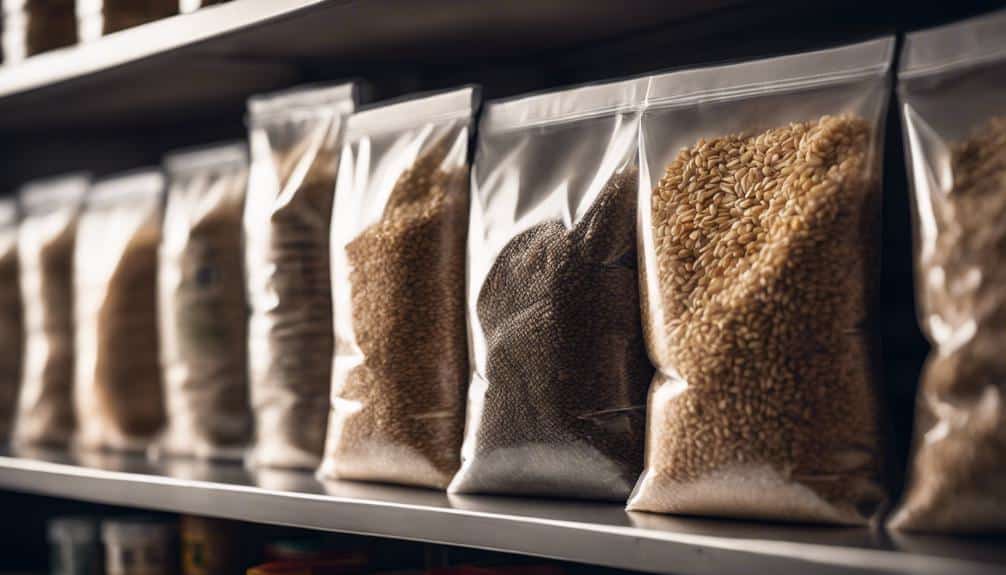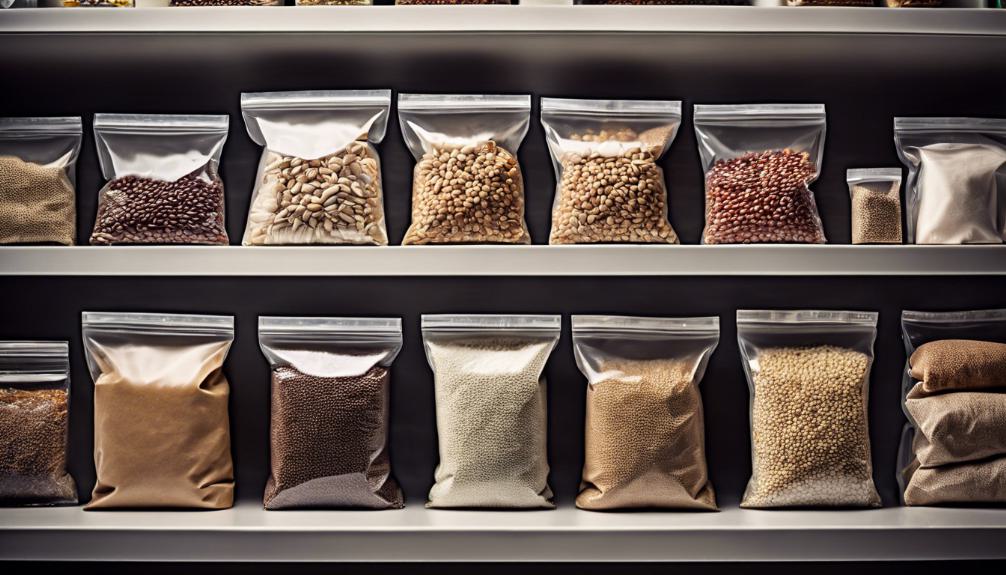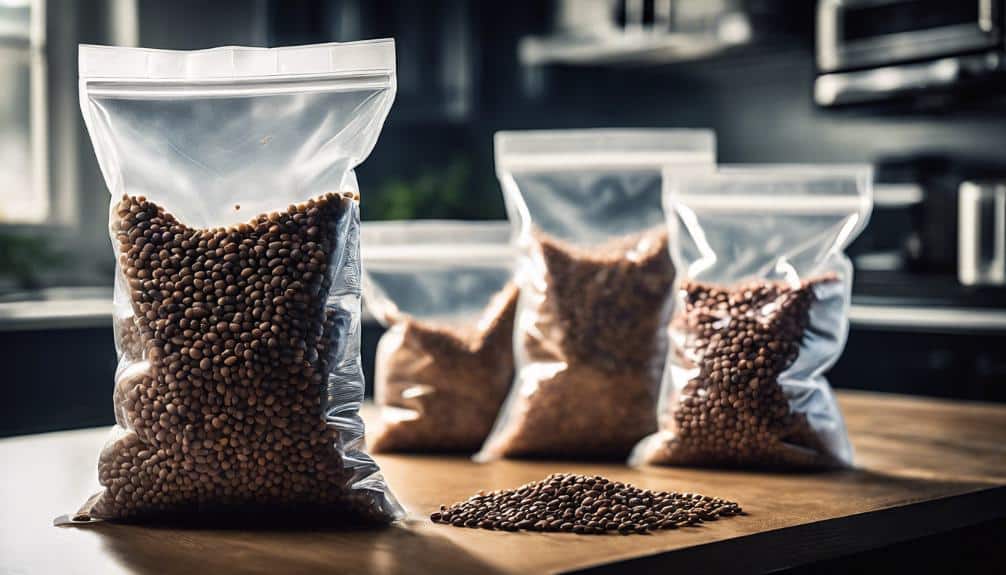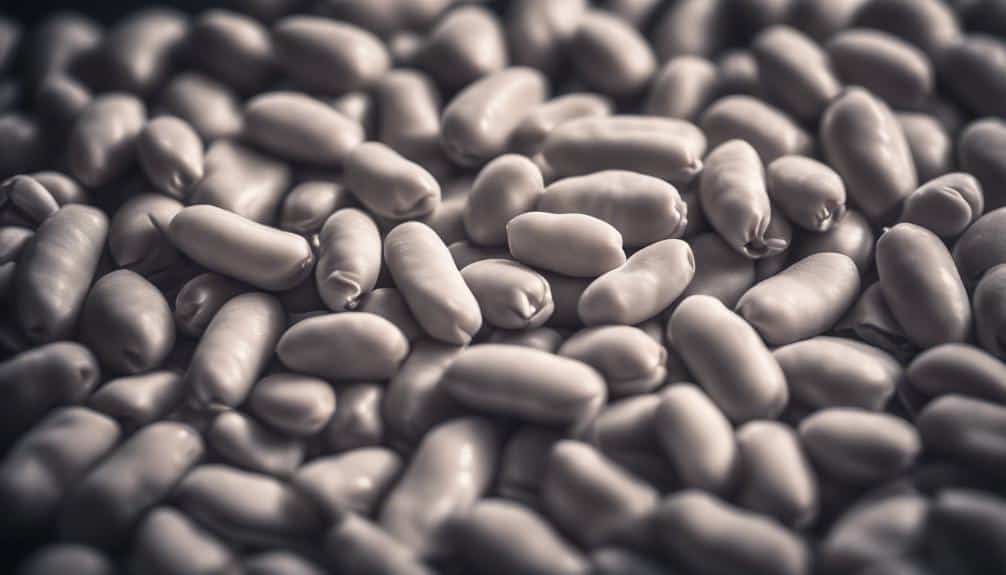When you’re looking to freeze and vacuum seal your produce, start by selecting fresh, ripe fruits and vegetables. Wash and dry them thoroughly to prevent ice crystal formation, which can degrade texture.
For items like berries or slices of bell pepper, pre-freeze them on a tray before sealing to keep pieces from sticking together. Use a vacuum sealer to remove all air from the bags, as air can cause freezer burn.
Label each package with the date and contents.
Properly sealed, your produce can last several months in the freezer, maintaining taste and nutritional value. Explore further to optimize your methods for different types of produce.
Here is a guide we wrote on how to build root celars easily. If your urban garden has very small space you can follow the vertical garden tips we explained here.
How to store grains for long term?

To effectively store grains long-term, you’ll need to keep them in a cool, dry place away from direct sunlight. Temperature control is essential; ideally, you should maintain a storage environment at or below 60 degrees Fahrenheit. This cooler temperature slows down the degradation process, guaranteeing your grains stay fresh and viable for extended periods.
You’ll want to focus on moisture monitoring. Too much humidity can invite mold and spoilage. Aim to keep the relative humidity around 15% to 20%. This might mean using desiccants or a dehumidifier in particularly damp climates to protect your grains. Regular checks with a humidity gauge can help you maintain this balance, giving you the power to adjust conditions as needed.
Pest prevention is another key aspect. Ensure your storage containers are airtight and made of sturdy materials like metal or thick plastic. These barriers deter insects and rodents, safeguarding your grains from infestations.
Consider adding bay leaves or diatomaceous earth inside storage containers as natural deterrents.
Why is proper storage of grains important?
Properly storing your grains safeguards their nutritional value and extends their shelf life, ensuring you have a reliable food source for the future. Grain spoilage prevention is critical; it isn’t just about keeping your pantry full, it’s about maintaining your freedom to choose healthy, unspoiled food whenever you need it.
Moisture control methods are your first line of defense against the loss of quality in grains. Excess moisture can lead to mold growth and spoilage, which compromises the nutritional integrity and taste of your grains. By managing moisture, you’re taking a proactive step in protecting your health and your pantry.
Pest management strategies are equally important. Insects and rodents don’t just consume your food, they also contaminate it, making it unsafe.
How to store beans and grains?

The traditional methods of storing grains have proven effective over time, but let’s explore what modern techniques can offer.
You’ll find that understanding these storage strategies can greatly extend your food’s shelf life and maintain its quality.
how long can grain be stored in silos?
Grain stored in well-maintained silos can remain fresh for up to ten years, depending on the type and storage conditions. To guarantee this longevity, it’s crucial you adopt effective silo maintenance practices. Regularly inspect your silos for any signs of damage or leaks, and repair them promptly to safeguard your grains from environmental exposure.
Temperature control techniques also play a pivotal role. Aim to keep your silo cool and dry, as high humidity and temperatures can lead to spoilage. Employ pest management strategies diligently.
Implement routine checks for insects and rodents, and use safe, effective deterrents to keep these pests at bay. By taking these steps, you’ll maximize the shelf life of your grains, giving you freedom from frequent restocking.
Storing beans for years?
To guarantee your beans and grains last for years, store them in airtight containers in a cool, dry place. Managing bean moisture control is essential; it prevents spoilage and maintains quality. Opt for innovative bean containers that offer superior sealing capabilities to enhance longevity.
Here are key strategies to maximize storage life:
- Use silica gel packs to absorb excess moisture.
- Maintain an ideal bean temperature between 50-70°F.
- Regularly check for signs of spoilage such as mold or pests.
- Keep your storage area dark to prevent degradation from light exposure.
- Rotate your stock; use older beans first and replenish with fresh stock to keep your supply vibrant and usable.
Traditional method of storing grains
Historically, people have stored grains and beans in cool, dry cellars or granaries to maintain their freshness and prevent spoilage. You’ll want to keep this tradition alive by mastering moisture content control, essential to preserving your harvest. Make sure that your storage area is well-ventilated and that the grains are dry before storing.
Use grain milling techniques wisely; milling too soon can expose the grains to moisture and pests.
Focus on harvesting practices that support longevity; harvest during dry conditions to minimize moisture exposure. Regularly check the moisture levels and keep them low to avoid mold and decay.
How to preserve legumes?

When it comes to preserving legumes, you’ll want to start by storing the seeds properly. Make sure they’re completely dry before you place them in airtight containers or vacuum-sealed bags.
This method will help maintain their quality and extend their shelf life considerably.
Storing legumes seeds
Properly storing legume seeds can greatly extend their shelf life and maintain their nutritional quality. You’ll want to focus on seed germination rates, moisture control methods, and temperature impact analysis to guarantee ideal preservation.
Here are some key tips:
- Store in a cool, dry place: Keep seeds away from heat sources to maintain viability.
- Use airtight containers: This protects them from moisture and pests.
- Monitor humidity levels: Moisture can cause spoilage or decreased germination rates.
- Check regularly: Inspect your seeds for any signs of mold or pests.
- Label containers: Note the date of storage to keep track of freshness.
Storing dry beans long term

To guarantee your dry beans remain fresh for years, store them in airtight containers in a cool, dark place. Managing bean moisture control is important; too much humidity can lead to spoilage and loss of quality.
You’ll want to keep a close eye on temperature impact analysis, making sure your storage area remains consistently cool to prevent any deterioration of the beans. Best container options range from glass jars with tight-sealing lids to heavy-duty Mylar bags with oxygen absorbers.
These choices not only preserve freshness but also protect against pests and light, which can degrade your beans.
Once you’ve chosen the right container, fill it, leaving a little headspace to allow for any air circulation that might be necessary, though minimal. Seal the container tightly; if using Mylar bags, make sure you press out as much air as possible before sealing. Label each container with the date, so you’ll always know how long they’ve been stored.
Frequently Asked Questions
Can You Vacuum Seal Fresh Herbs for Freezing?
Yes, you can vacuum seal fresh herbs to enhance flavor retention. Effective sealing techniques like this are key herb preservation methods, ensuring you’re free to enjoy their fresh taste for months.
Does Blanching Affect the Taste of Frozen Vegetables?
Blanching benefits your veggies by enhancing flavor retention and nutrient impact, ensuring you enjoy the freshest taste and health benefits, even after storage. You’re in control of preserving their natural goodness!
How Long Can Vacuum-Sealed Fruit Last in the Freezer?
You’ll find vacuum-sealed fruit can last up to a year in the freezer, ensuring peak flavor retention and nutrient preservation. Follow storage tips closely to maximize freshness and enjoy delicious, healthy fruit anytime.
Are There Vegetables That Shouldn’t Be Frozen?
Yes, you should avoid freezing vegetables like lettuce and cucumbers, as texture changes can ruin them. Focus on ideal varieties known for good nutrient retention, ensuring you experience freedom in your culinary choices.
What Is the Best Way to Label Vacuum-Sealed Packages?
To label your packages, you’ll want to choose writing tools that guarantee label durability and consider visibility factors. Use permanent markers and clear, weather-resistant labels to maintain readability and long-term identification.
